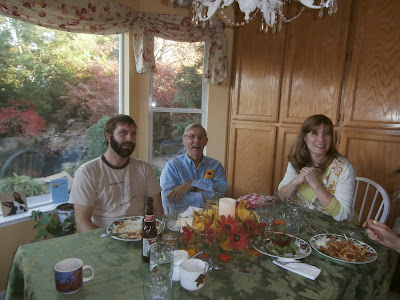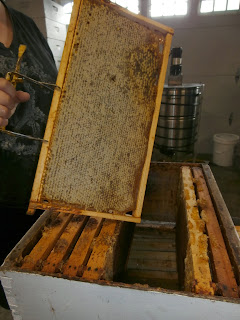Honey Harvest! And I only helped with the last box.
When you see bee hives in a field they look like several boxes on top on one another. Inside they have frames with a space between each one. The bees make wax combs on the frames and fill the combs with pollen, larva or honey.
This picture shows the frames of honey in a box. They are close together and sometimes the little bees get over creative and add wax comb to the sides of the frames which makes the frames hard to remove. The special tool Cathy is holding the frame with helps get the frames out of the box.
The little girl bees fill the combs with honey and cap them off at the top with wax.
The caps have to be removed and this is done with an hot electric knife. It isn't really sharp but because it is hot it just melts the caps off.
And da-ta! Pure, natural honey. Yum yum!
Then the frames are put in an extractor, that metal drum looking thing. It spins the frames pulling out the honey.
The honey can be drained out the bottom of the extractor, and strained the first time to get out all the larger pieces of wax separated out.
The honey will be strained again and bottled. This harvest was from 2 stacks of boxes about 8' high each. And each box has 8 or 9 frames in them each. The honey filled frames are each really heavy so it is a lot of work.
After the honey is finished, Cathy gets to be creative with the wax.
All the wax from taking the caps off the combs is saved, melted on low heat. The wax has a lot of honey in it that separates when the wax is heated and the wax goes to the top and can be removed when cooled. The heated honey is not bottled for sale because heat can destroy some of the beneficial properties that help with allergies, etc.
 |
| Wax ready for projects. |
Cathy has made lip balm and candles from the wonderfully fragrant bees wax.
So after my small bit of honey help, I did a little more work on the bodice. The sleeves are now attached and the lining is added but the bottom hem area is still open.
Next steps on the bodice: clip some seams, take out basting threads, tack down certain areas of the lining, hook and eyes, final alterations to the collar, add the boning to the casings and hem the sleeves. Then the next big decision is how to finish the bodice bottom. I'm going to have to do some research since I don't have a picture of the back of this dress. This bodice has pleats in the back but I think they would look to casual for this dress.
Update on Fabric.com: still haven't heard from them......

















































